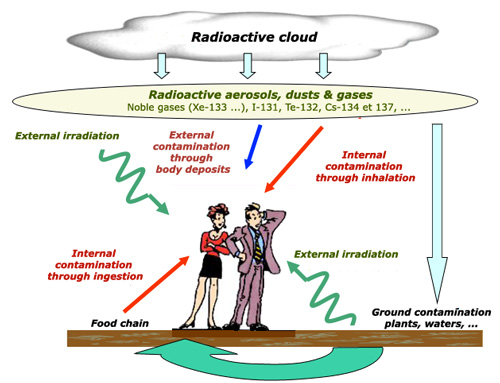What are the exposition pathways after a major accident ?
What is the impact on man of a major release of radioactivity into the environment? What are the exposure pathways when large amounts of radioactive atoms are released into the atmosphere? This happened at the time of the 1950-1960 atomic bombs tests and after the Chernobyl and Fukushima nuclear accidents.

Impacts of a major radioactive release on men
Various paths of exposure after a major release of radioactivity and the passage of a radioactive cloud. Radioelements present in radioactive cloud are fission products including notably short lived iodine and long lived caesium isotopes. Deposited on the ground, these radioactive atoms contaminate the food chain. Inhaled or ingested, they will be the source of internal exposures in addition to external expositions coming from air and ground.
© Abdel-Mjid Nourreddine, IPHC Strasbourg
– Radioactive cloud.The passage of a radioactive cloud is the source of exposure to gamma rays. The ranges of beta electrons in air are at most a few meters while these of alpha rays are only of the order of a few centimeters. The gamma exposure is external and lasts the time the cloud passes at the vertical above our heads. The higher the cloud, the more the radiation is attenuated by the atmosphere at ground level. The effects would be generally low, similar to an X-ray radiography. The psychological effects are more important, as evidenced in France by the emotion aroused in 1986 by the arrival of the Chernobyl cloud
– Aerosols and radioactive dust Radioactives gases, dusts and aerosols from the cloud carry a more dangerous radioactivity since it can reach humans directly. The main gases are radioactive isotopes of xenon and krypton, noble gases chemically inert, which can not be assimilated. They become diluted in the wide volume of the atmosphere. Radioactive isotopes of iodine are also present in gaseous states or fixed on aerosols and dusts along with other elements more durable such as cesium-134 and 137. Inhaled, these radioelements are the source of internal exposures or when deposited on the skin of exposures by contact.
Inhalation of radioiodine is dangerous because of its fixation on the thyroid. Radioactive iodine isotopes are fortunately short lived. The main one is iodine-131. One should wear masks in in the vicinity of the releasse site as long as the risks are high. Their concentration decreases rapidly when rain and snow,clean the air by bringing back on the ground dust and aerosols.
– Ground deposits Unlike previous contamination, contamination from deposition of radioactive atoms on the ground is meant to last. Gamma rays emitted by radioactive elements present on the ground surface or near the surface are sources external exposures. The main gamma emitter is cesium-137 whose radioactive half-life is 30 years. The detection of cesium-137 gamma characteristics gamma of cesium-137 has allowed to draw detailed maps of ground deposits resulting from atmospheric nuclear tests or after the Chernobyl and Fukushima accidents.
– Contamination of ground, plants and of the food chain Aerosols and radioactive dust from the atmosphere are deposited by rain and winds to the ground. Some are deposited on vegetation. Broad leafy vegetables, grass grazed by livestock are affected. These deposits on vegetation contaminate the food chain, for example through milk, meat, salads, if precautions are not taken especially during the first weeks after the release (Iodine-131 disappears within 3 months). In subsequent years, the assimilation of radioactive atoms present in the ground goes by the roots, a process much less effective.
– Water contaminations : marine pollution Rainwater who has cleaned the atmosphere or leached contaminated soils inherits radioactivity. This water flows. In the Bay of Fukushima, a portion of the cesium carried by coastal rivers, contributed to the contamination of sand and sediment. In the open ocean, contamination from radioactive deposits becomes low due to dilution within an enormous volume. This is not the case near the coast. In the Fukushima bay, most of the cesium is transferred from water to sediments. Fishes and shellfishes that burrow these sediments were most likely to be contaminated. By the way, it should be remarked that there is virtually no external exposure in water, since gamma are aborbed efficiently by water.
– External and internal expositions External expositions are less dangerous than internal expositions. On can avoid them by moving away from the source, or by taking shelter. Gamma rays irradiate the whole body and do not select a particular organ or tissue. On the contrary, an alpha or beta emitter set in the lungs, thyroid or bone structure would be more radiotoxic, making itself felt in the lungs, thyroid or bone over a period that can be long.
Other articles on the subject « Accidental Releases »
Atomic bombs legacy
A legacy of the cold war The residue of radioactive contamination which still endures has its ori[...]
Atmospheric Releases
Atmospheric radioactive pollution after a major accident During a major accident, radioactive mat[...]
Risks of ground deposits
Two deposition modes: dry deposits and wet deposits In ordinary life, apart from the vicinity of [...]
Risks of Internal Exposure
After an accident : what impact on food and man ? A large amount of radioactivity was dispersed i[...]